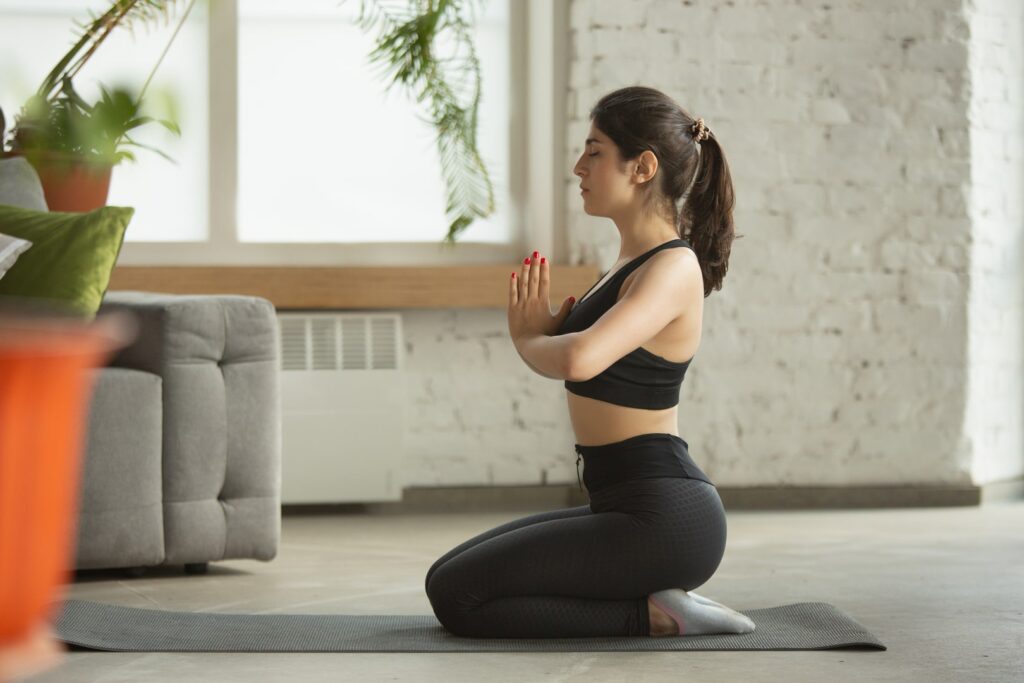As exams get closer, students often feel stressed and anxious, which can affect their focus and performance. Including yoga in their daily routine can teach helpful techniques to improve concentration and keep a balanced mind. Yoga not only boosts physical health but also encourages mindfulness, helping students manage the demands of academic life with more ease.
Here are five effective yoga tips to help students improve focus and balance during stressful times. These practices can create a calm and focused environment, bringing clarity of thought and emotional stability, allowing students to approach their studies with confidence and composure.

Tip 1: Start with Breathing Exercises
Breathing exercises are an important part of yoga that can help improve focus and calmness, especially during stressful exam times. Deep, conscious breathing helps students center themselves, lower anxiety, and improve concentration. Focusing on the breath allows students to stay grounded in the present moment, which is essential for effective studying and test-taking.
One technique to try is the 4-7-8 breathing method. To do this, sit comfortably in a quiet place and follow these steps: breathe in deeply through your nose for four counts, hold your breath for seven counts, and then slowly breathe out through your mouth for eight counts. This practice not only relaxes your nervous system but also boosts oxygen flow to your brain, which helps improve your thinking. Doing this for a few minutes before studying or during breaks can help clear your mind and focus, making your study sessions more effective.
Another good technique is diaphragmatic breathing. Place one hand on your chest and the other on your belly to make sure you are using your diaphragm for deeper, more efficient breaths. This method helps reduce stress and creates a calm feeling, which is helpful for learning. By making breathing exercises a regular part of their day, students can become more resilient to exam stress, improving their performance and overall well-being.
Tip 2: Incorporate Mindful Movement
Adding mindful movement to a student’s daily routine can greatly improve focus and clear thinking during exam time. Mindful movement means doing yoga poses with awareness and purpose, helping students connect their body and mind. This link is important for better concentration and keeping balance, both mentally and physically.
Starting with easy poses like the Mountain Pose can help students feel grounded and centered. To do Mountain Pose, stand tall with feet as wide as the hips, and let your arms hang by your sides. As you breathe in, lift your arms up toward the sky while pressing your feet firmly into the floor. This pose helps with stability and is a reminder to stay strong during academic challenges.
Another great pose to try is Warrior II. This pose builds strength and focus by opening the hips and chest while stretching the arms wide. To do Warrior II, step one foot back, bend your front knee, and look over your front hand. Holding this pose helps develop confidence and determination, which is useful during exams.
Besides specific poses, students can try flowing sequences like Sun Salutations. These sequences help create a smooth flow and rhythm, helping the mind become calm and focused. As students move through each pose, they should match their breath with their movements, building mindfulness that can benefit their study time.
Adding mindful movement to daily routines helps relax tense muscles and gives the mind a break. This practice lets students step away from studying, recharge, and come back with better focus and a clearer mind, which helps them perform better during exams.







Tip 3: Create a Consistent Practice Routine
Having a regular yoga routine helps students improve focus and balance, especially during stressful exam times. Just like studying needs regular effort, so does yoga. Sticking to a routine not only strengthens the benefits of yoga but also builds discipline that can help in other parts of school life.
To start, students should pick a time that works best for them. It could be early in the morning to start the day on a good note, during a lunch break for a quick refresh, or in the evening to relax. The key is being consistent. Even spending 15-30 minutes a day can make a big difference. Choosing a set time every day helps build a habit, making it easier to fit yoga into a busy schedule.
Students should plan how their yoga session will go. Start with a warm-up to loosen the body, then do poses that build strength and flexibility, and finish with relaxation, like Savasana (Corpse Pose). A simple routine could include Child’s Pose, Downward-Facing Dog, and Seated Forward Bend, which help relax the body and mind.
Keeping a journal to track progress can also help. Students can write down how they feel before and after each practice. This can build self-awareness and motivate them to keep going. Over time, they might see better focus and improved stress control.
Finally, students can join online classes or community groups to help them stay accountable. Practicing with others, even online, can keep them committed and help them learn new techniques. By making yoga a regular part of their routine, students will build a strong base for focus and balance, helping them face exam stress with more confidence.
Tip 4: Use Yoga to Manage Stress and Anxiety
During exam time, stress and anxiety can feel overwhelming and make it hard for students to focus and do their best. Yoga has helpful ways to manage these feelings and bring calm and balance, which can improve focus. By adding specific yoga techniques to their routine, students can handle the stress of studying and exams more easily.
A good way to relax is by doing poses that help release tension. Poses like Legs-Up-the-Wall (Viparita Karani) and Supported Bridge Pose (Setu Bandhasana) can calm the nervous system and reduce anxiety. For Legs-Up-the-Wall, students lie on their backs with their legs up against a wall, letting gravity help them relax. This pose not only releases body tension but also encourages deep, calming breaths to quiet the mind.
Also, practicing yoga nidra, or yogic sleep, is very helpful for managing stress. This guided meditation helps you deeply relax and can be done in just 20 minutes. Students can find online sessions that guide them through body scans and breathing exercises, creating a strong feeling of calm and reducing anxiety.
Adding mindfulness to yoga is another great way to handle stress. Students should focus on being present during poses, noticing how their body feels and any thoughts they have without judgment. This practice helps build awareness and acceptance, which is especially useful when dealing with school stress.
Finally, the inclusion of affirmations in the yoga sessions will assist in developing a positive attitude. The student can repeat words such as “I am capable” or “I approach my studies with calmness” during the practice in order to channel their inner self and reduce anxiety. Through yoga as a stress-relieving activity, students can set up an enabling atmosphere that fosters focus, resiliency, and well-being at exams.
Tip 5: Reflect and Set Intentions
Yoga’s potent techniques of introspection and intention-setting can greatly improve a student’s ability to concentrate and maintain equilibrium during test season. In addition to promoting mental clarity, reflecting on one’s objectives and desires can help one develop a positive outlook, which can increase academic achievement. Students can develop resilience and motivation by incorporating these techniques into their yoga regimen.
Students might ask themselves thought-provoking questions at the start or finish of a yoga practice to promote self-reflection. What goals do I have for this exam season? How can I best take care of my emotional and mental health? Students who give these topics more thought can become more clear about their priorities and the actions they must take to meet their academic objectives. A physical reminder of their goals might also be obtained by having them write down their ideas in a journal.
Another powerful strategy for developing a focused mentality is to set intentions prior to a practice. A simple phrase or word that speaks to the student’s goals during the exam time, such “focus,” “calm,” or “determination,” can serve as an intention. Students can focus their energies on their objectives by saying this purpose out during their exercise. For instance, they can mentally recite their objective as they move into positions, strengthening their will to stay balanced and focused.
By going over their original goals again and evaluating how well they’ve adhered to them, students can also evaluate their progress during exam season. By encouraging responsibility and flexibility, this approach enables students to modify their habits or attitudes as necessary. Yoga is a useful ally in the exam journey because it helps students develop a habit of introspection and intention-setting, which not only improves academic performance but also fosters a deeper connection to their personal growth and well-being.
Conclusion
Including yoga in a student’s study regimen during test season provides a comprehensive strategy for stress management, improving concentration, and fostering general wellbeing. Students can build a supportive environment that promotes clarity and resilience by beginning with breathing exercises, incorporating mindful movement, developing a regular practice, using yoga to battle anxiety, and reflecting on personal aspirations. These techniques not only give children the tools they need to confidently face the demands of school, but they also promote a more balanced, healthy attitude to learning and self-care. Students who embrace yoga as a tool for balance and focus are better equipped to handle test season with composure and purpose, which eventually results in a more fruitful and satisfying academic career.



